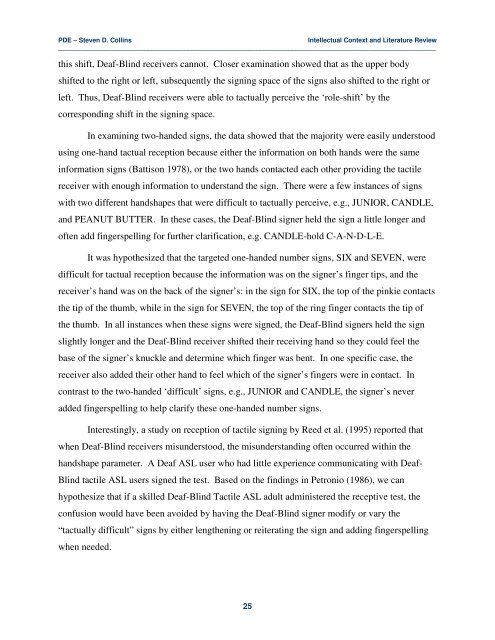Adverbial Morphemes in Tactile ASL - Gallaudet University
Adverbial Morphemes in Tactile ASL - Gallaudet University
Adverbial Morphemes in Tactile ASL - Gallaudet University
You also want an ePaper? Increase the reach of your titles
YUMPU automatically turns print PDFs into web optimized ePapers that Google loves.
PDE – Steven D. Coll<strong>in</strong>s<br />
Intellectual Context and Literature Review<br />
_________________________________________________________________________________________________________<br />
this shift, Deaf-Bl<strong>in</strong>d receivers cannot. Closer exam<strong>in</strong>ation showed that as the upper body<br />
shifted to the right or left, subsequently the sign<strong>in</strong>g space of the signs also shifted to the right or<br />
left. Thus, Deaf-Bl<strong>in</strong>d receivers were able to tactually perceive the ‘role-shift’ by the<br />
correspond<strong>in</strong>g shift <strong>in</strong> the sign<strong>in</strong>g space.<br />
In exam<strong>in</strong><strong>in</strong>g two-handed signs, the data showed that the majority were easily understood<br />
us<strong>in</strong>g one-hand tactual reception because either the <strong>in</strong>formation on both hands were the same<br />
<strong>in</strong>formation signs (Battison 1978), or the two hands contacted each other provid<strong>in</strong>g the tactile<br />
receiver with enough <strong>in</strong>formation to understand the sign. There were a few <strong>in</strong>stances of signs<br />
with two different handshapes that were difficult to tactually perceive, e.g., JUNIOR, CANDLE,<br />
and PEANUT BUTTER. In these cases, the Deaf-Bl<strong>in</strong>d signer held the sign a little longer and<br />
often add f<strong>in</strong>gerspell<strong>in</strong>g for further clarification, e.g. CANDLE-hold C-A-N-D-L-E.<br />
It was hypothesized that the targeted one-handed number signs, SIX and SEVEN, were<br />
difficult for tactual reception because the <strong>in</strong>formation was on the signer’s f<strong>in</strong>ger tips, and the<br />
receiver’s hand was on the back of the signer’s: <strong>in</strong> the sign for SIX, the top of the p<strong>in</strong>kie contacts<br />
the tip of the thumb, while <strong>in</strong> the sign for SEVEN, the top of the r<strong>in</strong>g f<strong>in</strong>ger contacts the tip of<br />
the thumb. In all <strong>in</strong>stances when these signs were signed, the Deaf-Bl<strong>in</strong>d signers held the sign<br />
slightly longer and the Deaf-Bl<strong>in</strong>d receiver shifted their receiv<strong>in</strong>g hand so they could feel the<br />
base of the signer’s knuckle and determ<strong>in</strong>e which f<strong>in</strong>ger was bent. In one specific case, the<br />
receiver also added their other hand to feel which of the signer’s f<strong>in</strong>gers were <strong>in</strong> contact. In<br />
contrast to the two-handed ‘difficult’ signs, e.g., JUNIOR and CANDLE, the signer’s never<br />
added f<strong>in</strong>gerspell<strong>in</strong>g to help clarify these one-handed number signs.<br />
Interest<strong>in</strong>gly, a study on reception of tactile sign<strong>in</strong>g by Reed et al. (1995) reported that<br />
when Deaf-Bl<strong>in</strong>d receivers misunderstood, the misunderstand<strong>in</strong>g often occurred with<strong>in</strong> the<br />
handshape parameter. A Deaf <strong>ASL</strong> user who had little experience communicat<strong>in</strong>g with Deaf-<br />
Bl<strong>in</strong>d tactile <strong>ASL</strong> users signed the test. Based on the f<strong>in</strong>d<strong>in</strong>gs <strong>in</strong> Petronio (1986), we can<br />
hypothesize that if a skilled Deaf-Bl<strong>in</strong>d <strong>Tactile</strong> <strong>ASL</strong> adult adm<strong>in</strong>istered the receptive test, the<br />
confusion would have been avoided by hav<strong>in</strong>g the Deaf-Bl<strong>in</strong>d signer modify or vary the<br />
“tactually difficult” signs by either lengthen<strong>in</strong>g or reiterat<strong>in</strong>g the sign and add<strong>in</strong>g f<strong>in</strong>gerspell<strong>in</strong>g<br />
when needed.<br />
25
















